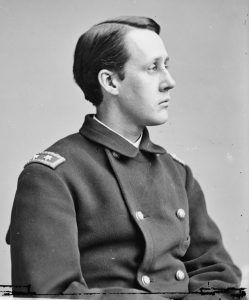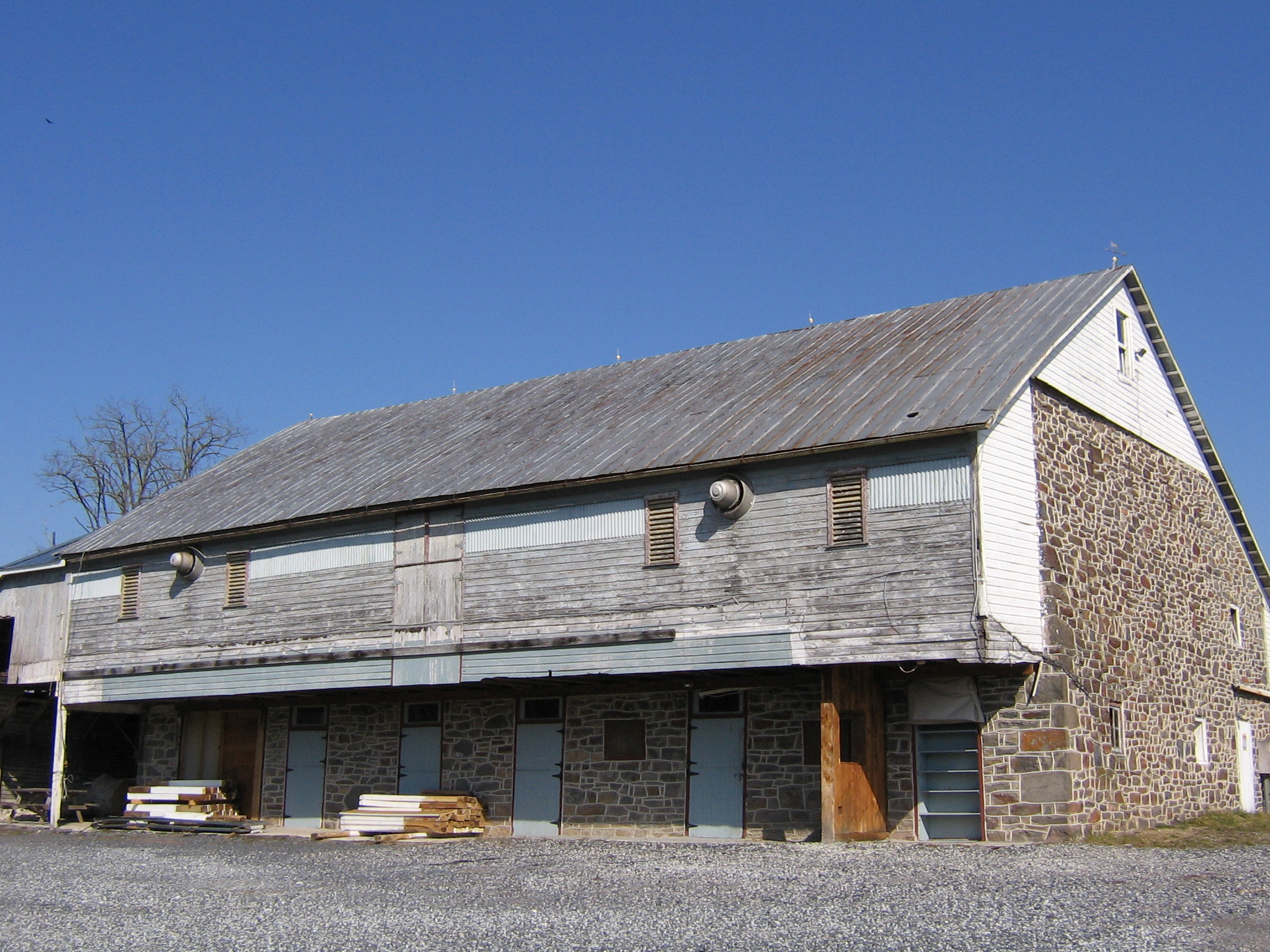Gettysburg Off the Beaten Path: Josiah Benner Farm

On the north side of Rock Creek, and along the west side of the Harrisburg Road, sits the Josiah Benner Farm. At the time of the battle, the farm encompassed 123 acres of the Gettysburg battlefield.
On the afternoon of July 1st, 1863, men of the Union 11th Corps established a battle line on the plain north of Gettysburg. The 3rd Division of the 11th Corps stretched from the shadow of Oak Ridge and toward the Carlisle Road. Extending this line to the east was the corps’ 1st Division commanded by 28-year-old Brig, Gen. Francis C. Barlow. The New York native had recently assumed command of the division after a disastrous performance by its former division commander Charles Devens at the Battle of Chancellorsville. While Barlow lacked a West Point education (in fact none of the 11th Corps division commanders attended West Point), he possessed both a brilliant mind, having been educated at Harvard, and a fighting spirit.
Barlow joined the Union Army as a private shortly after the firing on Fort Sumter, and by early 1862 he was a colonel at the head of the 61st New York Infantry. A veteran of the Seven Days Battles and Antietam where he was twice wounded, Barlow was described as having a “most distinguished bravery…[and] utmost coolness and quickness of perception, the greatest promptitude and skill in handling troops under fire,” according to former brigade commander John C. Caldwell. Although slight of build, he had an inner fire of a man three times his size. In that vein, he carried a massive curved cavalry saber that nearly scraped the ground. The harsh disciplinarian used the flat of the sword to smack soldiers across their backs.

Barlow joined the 11th Corps on April 17, 1863, and assumed command of a brigade in the 2nd Division of the corps. His appointment to a corps that was seeing a shakeup in the command structure did not sit well with many soldiers. His “abrupt” cold style had one veteran of the 11th Corps dubbing him a “martinet.”
Barlow’s brigade missed much of the fighting at Chancellorsville, having been dispatched from the 11th Corps line to the support of the 3rd Corps moving toward Stonewall Jackson’s flanking column at the Catharine Furnace. Major General Oliver Otis Howard a Barlow fan and his superior officer rode along with the brigade. Thus, at 5:15 PM that evening, Barlow’s men were not present for Jackson’s flank attack. While Barlow and his men may not have been with the rest of the corps during their eventual route, the did share in the unwanted attention showered upon them after the battle by the rest of the Army of the Potomac.
In May, Barlow was appointed to head the 1st Division even though others had seniority/ “You know how I have always been down on the ‘Dutch’ & I do not abate my contempt now,” the xenophobic division commander complained after Chancellorsville—even as going so far as dubbing his men “these miserable creatures…” Like other officers in the 11th Corps, Barlow attempted to break free of the “Flying Dutchmen,” but to no avail. What followed was a hate-hate relationship between Barlow and the men under his command. An attempt to replace and the arrest of, a respected brigade commander, strict orders, and harsh punishments marred the division’s march toward Gettysburg.
Now finding himself at the head of an undersized division ready to do battle with the massing Confederate Army of Northern Virginia on July 1st, Barlow moved his men forward to a rise o ground known as Blocher’s Knoll. The Empire State general was not authorized to make this forward movement and it severely taxed the strength of the 11th Corps position as only two of its three divisions were deployed north of the town.
Atop Blocher’s Knoll (today known as Barlow’s Knoll), were four 12 lb. Napoleons of Battery G, 4th United States Artillery. While this battery commanded by Lt. Bayard Wilkeson sported six guns, only four could be deployed atop the hill, while the remaining section (2 guns) were deployed 200 yards down the Harrisburg Road in the direction of the town.
The bare knoll offered little protection and little advantage to Barlow’s men. With no support on their right and the Confederate divisions of Major Generals Robert E. Rodes and Jubal A Early deploying to roughly their left, front, and right Barlow’s 2,400 men found themselves in a poor position and badly outnumbered.
At the northern base of the knoll ran Rock Creek, and just beyond the creek sat the Josiah Benner Farm. The farmhouse, barn, and spring house are witnesses to the action as Early’s division rolled down the Harrisburg Road toward Blocher’s Knoll. Companies A, B, F, and K of Lt. Col. Douglas Fowler’s 17th Connecticut Infantry were deployed in and around the farm buildings and to the right of the Harrisburg Road. This makeshift battalion was commanded by Maj. Allen G. Brady. These four companies constituted Barlow’s forward right flank. The remaining six companies of the 17th Ct. moved to the top of Blocher’s Knoll on the south bank of Rock Creek. Barlow, Fowler, and Brady were all in a triangle of hatred toward one another. Barlow had Fowler arrested on the march north, and Fowler went over Barlow’s head to secure his release. Brady was passed over for promotion, losing out to Fowler. A finely tuned machine of war the 11th Corps at Gettysburg was not.
The four companies at the Benner Farm came under fire from Lt. Col. Hilary P. Jones’ battalion of Confederate artillery. “I never saw guns better served than Jones’ were on this occasion. Their fire was so rapid and concentrated,” claimed Maj. Campbell Brown. Brigadier General John B. Gordon’s Georgia Brigade and elements of Brigadier General Harry Hays’ Louisiana Brigade swept the Connecticut men from the field and then crossed Rock Creek. Fowler with the remaining companies of the 17th Connecticut mounted his horse and led a counterattack. Moments later he was decapitated by a Confederate shell. “[N]othing remained to screen our line from the crossfire that now
poured upon it from flank and front. The enemy’s batteries swept the plain
completely from two or three different directions, and their shells plunged
through our solid squares, making terrible havoc.”
Barlow was in the thick of the action as Gordon’s and Hays’ men were joined by the four Georgia regiments of Brig. Gen. George Doles. As his horse turned, Barlow was struck in the side by a bullet. Stumbling from his horse he tried to walk to the rear, but was hit once again, this time by a spent ball.

After the action died down the Benner Farm was used as a temporary field hospital. Francis C. Barlow was left behind in the 11th Corps route, Barlow was removed from the knoll to the shade of some trees by one of Early’s staff officers. The general was then taken by some of his captured men to the second floor of the Benner Farm. While there the general was examined by both Confederate and Federal doctors. All agreed that the wound was mortal. It was not. Barlow made a full recovery and rejoined the Army of the Potomac as part of the 2nd Corps in 1864. Barlow only spent only one night in the farmhouse, he was moved the next day to the home of John Crawford, on the north side of the town.
Another of the patients in the home was Theodore A. Dodge of the 119th New York. Dodge was wounded in the fight along Barlow’s line and he was taken to the farm. “I am lying on a bed at the house of a Mr. Benner’s…The action of yesterday (July 1) was short and sharp, Ewell’s (late Jackson’s) Corps again driving the Germans with fearful strength…The Confederates treated me kindly.” By July 3rd a “red flag (hospital) hung out,” on the side of the building. Dodge went on to tell of “a little incident.”
“There is a Confederate General in this house. His negro servant came into the room just now and looked around without saying anything until his eyes caught some new pennies on the table. He asked me if it was silver. I told him, No, there were cents, and gave him one. He then said, ‘Would you like some chicken for dinner?’ I said I would pay him for anything he would bring me. Shortly after he brought me some stewed chicken and some coffee, which was a great luxury, as I could get none anywhere else. He says he will fetch me some supper.”
Like many of its patients, the farm has been nursed back to health by the National Park Service and the American Battlefield Trust. The two groups were able to preserve 12 of the original 123 acres of land, which includes the home, barn, and spring house. In the artillery duel between Lt. Col. Hilary Jones’ battalion of Confederate artillery and Lt. Bayard Wilkeson’s Battery G, 4th United States Artillery, the home was struck by a number of shells. One shell is still lodged in the rear of the home.
To Reach the Josiah Benner Farm:
From the town square.
-Drive north from the square along Carlisle Street Bus. 15 North for 0.4 miles.
-At East Lincoln Avenue turn right.
-After one block bear left at the Y intersection and follow the Old Harrisburg Road (Bus. 15 North) for 0.80 miles.
-As you cross Rock Creek the farm will be to your left. Parking is available near the barn.
Authors Note: There are two Benner farm’s made famous by the battle. The other farm is the Christian Benner Farm, which will be discussed in another post. That farm is on the east side of Gettysburg.

The Josiah Benner Farm is one of my favorite Gettysburg farms. I like the traditional brick house architecture, but the added on wooden porch makes it a unique and instantly identifiable building. (And yes, the porch is shown in 1863 photographs.)
I also find it interesting that 3 CSA surgeons arrive at the farm to examine General Barlow, and the same surgeons care for him at the Crawford home, suggesting he may have been moved at their insistence and they were doctors with influence and rank. Unfortunately, Barlow neglected to mention the surgeons’ names, leaving this historian with many questions and much speculation.
I so hope it ends up in the hands of the park and not private and that living history programs would take place there.
We would like to know if either Josiah or Christian are relatives since we are Benners too. When I was at Gettysburg as we were LEAVING the cemetery, someone mentioned they saw a Benner headstone but we were on a bus!
Eleanor, I know of one relative who is also connected to my family but not via the Benners. Bill Benner lives in Dayton, OH and his daughter, Brenda Saunders, lives in Kettering, OH.
Please let us protect the Gettysburg Battlefield site and All its shrines and statues.
Great information. I’m glad to see preservation efforts to Benner Farm. Barlow is an interest of mine and subject of a book project I’m working on. Thank you for this post.